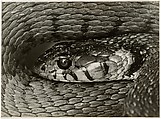Snake Head
Albert Renger-Patzsch German
Not on view
If Edward Weston was a champion of straight photography in America, August Sander and Albert Renger-Patzsch were its advocates in Germany, where it was labeled "new objectivity" (Neue Sachlichkeit). There were, however, differences between the approaches of these two German photographers. In his 1933 essay "A Short History of Photography," the German critic Walter Benjamin praised the scientific basis of Sander's physiognomic studies in The Face of Our Time, while he condemned photographs which proposed that "the world is beautiful," a barely disguised criticism of Renger-Patzsch's 1928 publication bearing this title. Benjamin's reproach of Renger-Patzsch was valid to the extent that comparisons between natural and manmade objects in the book do tend to draw attention to their formal structure.
It is, however, an injustice to reduce Renger-Patzsch's aesthetic to a superficial interest in cataloguing the forms of the objects that inhabit our world. Rather, like Weston, his was a search for the underlying essence and universality of those objects. About this image of a grass snake, one of the hundred photographs included in The World Is Beautiful, Carl Georg Heise wrote in the introduction: "The head of the snake fits into the coils of its body in such a way that the page seems filled with a decorative pattern of scales, a pattern which the viewer's imagination extends uncannily into infinity. Thus, above and beyond the single snake, the picture presents the entire species."
Due to rights restrictions, this image cannot be enlarged, viewed at full screen, or downloaded.

